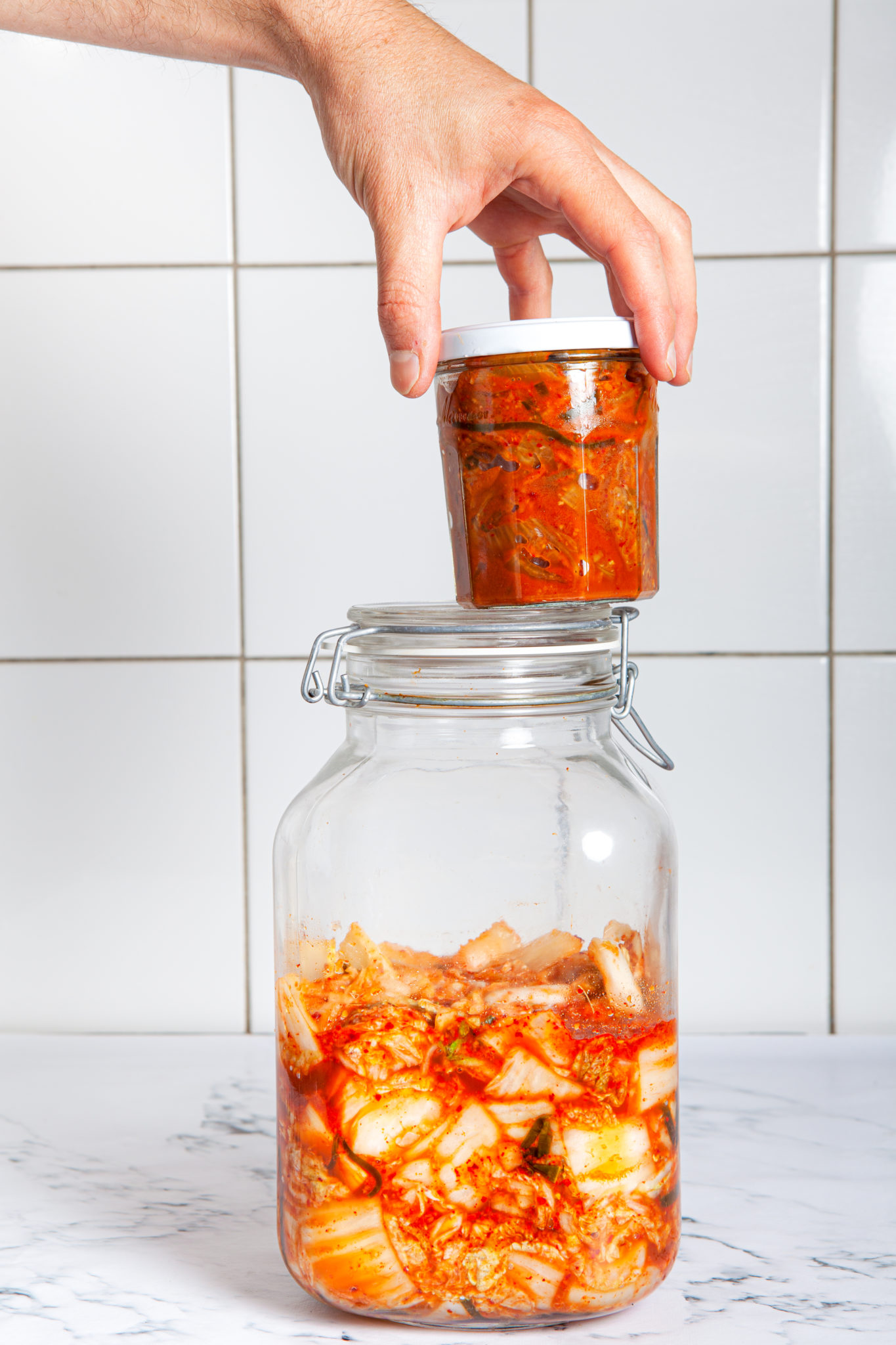I made a lot of kimchi the last years in my cooking workshops and pop up events. Every time people taste it, they ask for the recipe. So here you go. It is all here. Make it, enjoy it and spread the word.
Kimchi is a Korean dish of spicy fermented Chinese cabbage. What gives it its special spicy flavor is a Korean chili pepper called gochugaru. You can usually find it in the Asian toko’s.
Kimchi is spicy, red and sensual. It is enough to smell the chili paste with which it is fermeneted (and which you will prepare in the recipe) to get enough saliva going through your mouth. In this sense it is great to stimulate your appetite.

As all fermented foods it helps digestion and can really pump up any simple home meal.
Make a lot because it is addicting.
I used kombu which is a type of hard seaweed. You can find in natural food stores or in Asian toko’s. It gives the kimchi a very nice and delicate umami flavor.
In my method I let the kimchi sit in salt until it loosens up and becomes softer. Afterwards I squeeze all the liquids out but I don’t wash it with water (like they often do in other recipes). In my experience this keeps the kimchi more crunchy, compact and less soggy – which is the whole point letting it sit in salt.
This recipe comes from my new cookbook ENERGY. The book explains how different foods influence our well being, body and mind by using the 5 elements system from the Chinese traditional medicine. So which element do you think Kimchi is and why?
I’m really curious how your kimchi turned out so don’t be shy to send me some photos and tell your stories! Enjoy every little bite! 🙂

2 kg Chinese cabbage, cut into big chunks
60 gram salt
2 pieces of kombu (about 7 gram)
10 garlic cloves (about 35 gram)
70 gram ginger, peeled
120 ml maple syrup
¼ cup shoyu
8 spring onions, white and green parts included, cut into thin slices
2 carrots (about 200 gram), cut into matchsticks
35 gram gochugaro (korean chili pepper)
In a large bowl mix the chinese cabbage and sea salt. Cover with plastic foil and allow to soak for at least 2-3 hours. During this time the salt will distract water out of the cabbage and will make it more flexible.
Soak the kombu in water for about half an hour. When turning soft, cut into thin matchsticks. You can use the soaking water as a bouillon.
In a kitchen machine blend the garlic and ginger until you get a rough paste. You can also grate them or chop them very finely, both will work.
Mix the kombu, garlic, ginger, maple syrup, shoyu spring onion, carrots and gochugaro in a bowl – this will be the paste in which you will ferment the kimchi. It should already smell very aromatic and appetizing at this moment.
You should notice on the cabbage that it has losen its structure. Drain the water that leaked out of the cabbage and place the cabbage in a kitchen strainer (you can also perform this step in few parts). Press the cabbage strongly against the walls of the kitchen strainer to squeeze out the extra remains of water out of the cabbage. Press in a straight and firm movement. Do not massage ot squash the cabbage to prevent it from rubbing against itself- you don’t want it to become mooshy and soggy, but rather to stay firm and compact.
After you have squeezed all the water well out of the cabbage. Mix the cabbage lightly with the chili mixture. You could already eat this as a kimchi salad. Taste and add more of the different ingredients if necessary. All the different taste should be very outspoken, since during the fermentation process they will tone down.
Place the kimchi in a pickling jar and press it well to the bottom of the jar to prevent air sacs being formed. Air sacs can create molding which we want to avoid. Press until water starts to float on the surface. Now it is ready to ferment.
During the first days keep the jar at room temperature (18-22 degrees) with an open lid, to allow the carbon dioxide to evaporate for at least 3 days. After 3 days taste the fermented vegetables. Keep longer in room temperature to allow more fermentation to occur. When you like the taste, store the jar in the fridge or a cool place. I usually keep it for 1 week outside of the fridge, but some people keep it for weeks or even months. It all depends on your taste.


